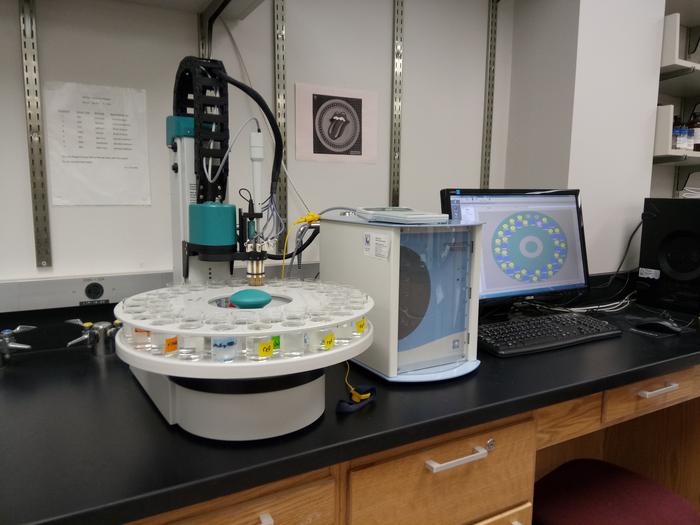PULLMAN, Wash. – While the electronic tongue bears little physical resemblance to its namesake, the strand-like sensory probes of the “e-tongue” still outperformed human senses when detecting contaminated wine in a recent study.

Credit: Washington State University
PULLMAN, Wash. – While the electronic tongue bears little physical resemblance to its namesake, the strand-like sensory probes of the “e-tongue” still outperformed human senses when detecting contaminated wine in a recent study.
In an experiment at Washington State University, the e-tongue identified signs of microorganisms in white wine within a week after contamination—four weeks before a human panel noticed the change in aroma. This was also before those microbes could be grown from the wine in a petri-dish. Winemakers traditionally rely on these two methods, sniffing the wine and petri-dish testing, to identify potential wine “faults” or spoilage.
The findings, detailed in the Journal of Food Science, indicate that e-tongue testing could augment those methods and allow winemakers to catch and mitigate problems sooner, said Carolyn Ross, WSU food science professor and the study’s corresponding author.
“If you ran a sample using the electronic tongue, we could learn after one week if there’s contamination or a wine fault problem, versus waiting up to four weeks running just sensory testing,” said Ross, who is also the director of WSU’s Sensory Science Center. “It’s really helpful with understanding wine quality.”
When immersed in a liquid, the e-tongue’s sensors can “taste” it by analyzing for the presence of certain compounds. At WSU, Ross’ team developed and programmed the instrument for various purposes including taking a type of “fingerprint” of wine, collecting a variety of information that may be of interest to winemakers.
“It gives good information about the holistic quality of the wines,” Ross said, though she noted that this type of analysis is best used to complement, not replace, other methods of judging wine quality.
In this study, the researchers purposely added four microbes to different bottles of Reisling. These microbes are known to contaminate white wine, causing spoilage and unpleasant odors, including nail polish remover, geranium and “mousy” odors. They trained a group of 13 volunteers to recognize a range of wine attributes by their aromas, both positive and negative, including these odors.
The trained panel then assessed the aroma of uncontaminated wine as a control and samples of the contaminated wine that had been stored for seven days to 42 days. The e-tongue was set to the same task and identified the contamination of all types after the first seven days of storage. The human sensory panel only started to detect contamination in some of the samples after 35 days of storage, a full 28 days after the e-tongue.
Ross and her colleagues have also tested out the e-tongue with red wine in an earlier study, and the team is continuing to develop the instrument housed at the WSU Sensory Science Center, building up a library to help inform its “tasting” abilities. Ross is currently looking for winery clients interested in the e-tongue capabilities to help assess the quality of their products.
This study received support from the Washington Wine and Grape Research fund and the U.S. Department of Agriculture. Additional co-authors on the study include first author Rachel Potter and Claire Warren of WSU and Jungmin Lee of the U.S.D.A. Agricultural Research Service.
Journal
Journal of Food Science
Article Title
Comparative assessment of Riesling wine fault development by the electronic tongue and a sensory panel
Article Publication Date
27-Mar-2024



